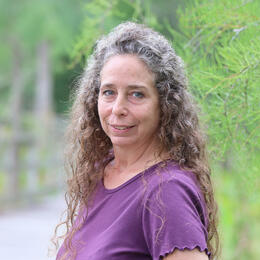What makes Corkscrew Swamp Sanctuary so special? It could be the 500-year-old bald cypress trees within the largest expanse of old-growth bald cypress forest remaining in the world, or it could be the biggest ghost orchid ever discovered. It could even be that the community came together in 1954 to protect this magical place from logging. But something else at the Sanctuary that is looked at daily is often overlooked. It has been walked on by more than a million people. It’s the 2.25-mile boardwalk that transports visitors into the heart of the swamp and offers them a glimpse of the spectacular Sanctuary that was saved so many years ago.
Early Days
In 1953, then-National Audubon Society President John H. Baker published an article in the Miami Herald proclaiming Corkscrew Swamp’s outstanding scientific and aesthetic value. Shortly thereafter, a flood of financial support from the local community, including several businesses, enabled the purchase of the first few thousand acres of land that were deeded to the National Audubon Society as a Sanctuary.
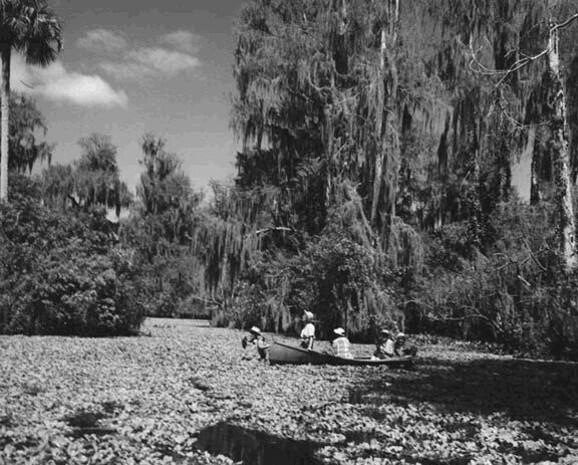
In 1954, the fledgling Sanctuary's vast, 5,680-acre wilderness was accessible only by four-wheel-drive vehicles along a remote dirt road. As more people started expressing interest in the scenery, wildlife, vegetation, and history, Audubon hired Henry (Hank) P. Bennett as the warden and first nature interpreter. He toured visitors through the lettuce lakes in canoes, but Sanctuary managers realized they needed a better way to immerse more visitors in this special place while keeping them dry.
The First Boardwalk
The local Whidden family completed construction on the first Corkscrew Swamp Sanctuary boardwalk, built with locally harvested cypress wood, in 1956. At the end of the boardwalk, visitors could walk right up to one of the largest trees in the Sanctuary. In its first year, the new boardwalk welcomed about 10,000 visitors.
Four years later, one of the biggest natural disasters in Florida’s history wrought havoc on this special place when Hurricane Donna lumbered ashore just south of Naples. She made landfall on Sept. 10, 1960, with winds of 120 mph. The large tree at the boardwalk’s end had its top broken off and barely survived, while entire sections of the boardwalk needed to be repaired or replaced.
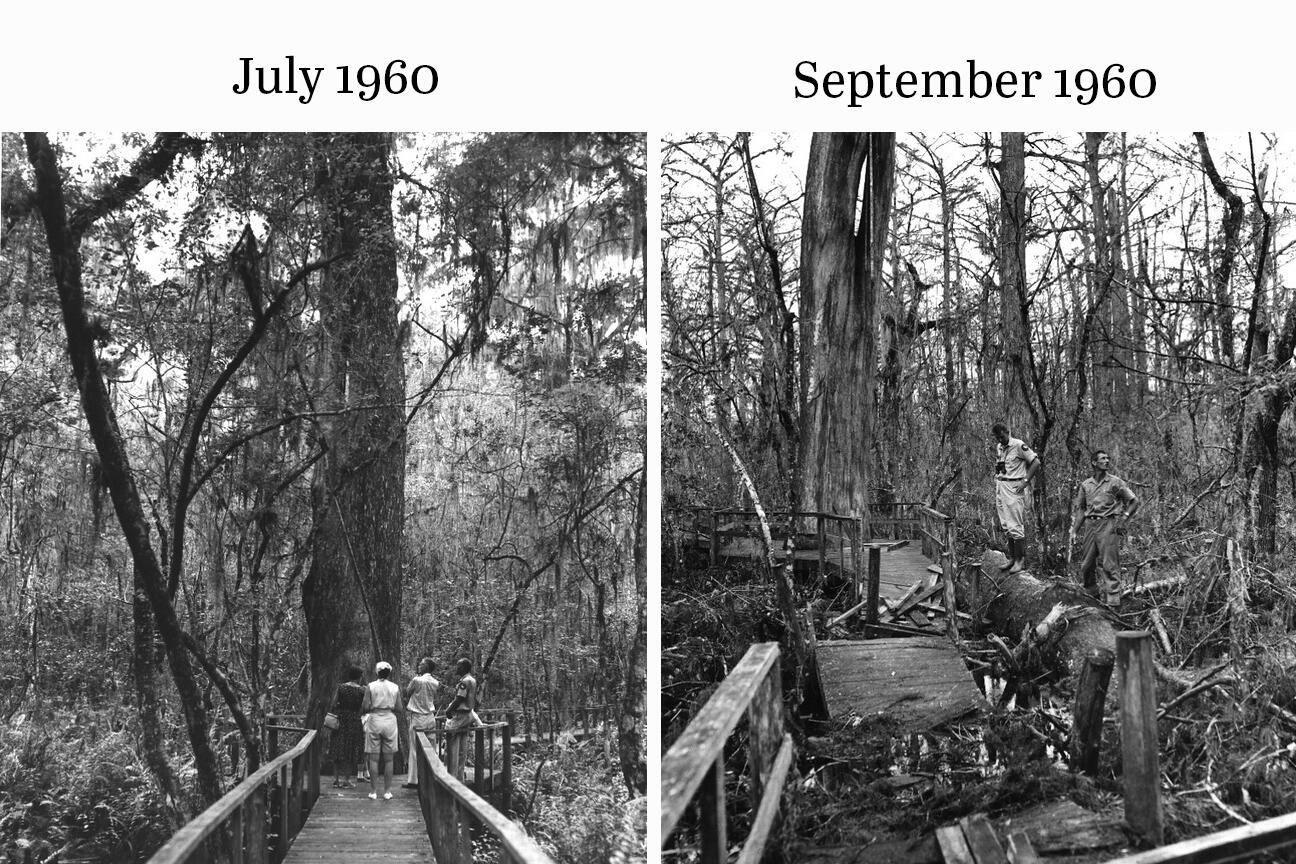
Boardwalk Expansion
By 1968, increasing use made it clear that the current boardwalk could not keep up with demand. It was crowded with so many visitors coming and going in opposite directions that managers added a loop to make it one way, with visitors returning via a different route. The new boardwalk trail began with a paved path from the visitor center through the pine flatwoods, then the boardwalk began at the edge of the pine flatwoods. It cut across the wet prairie just beyond the current Plume Hunters spur before circling around and eventually looping back to the entry point.
Staff and volunteers completed the final portion, the spur, and observation platform in the central marsh in 1969, taking its length closer to two miles.
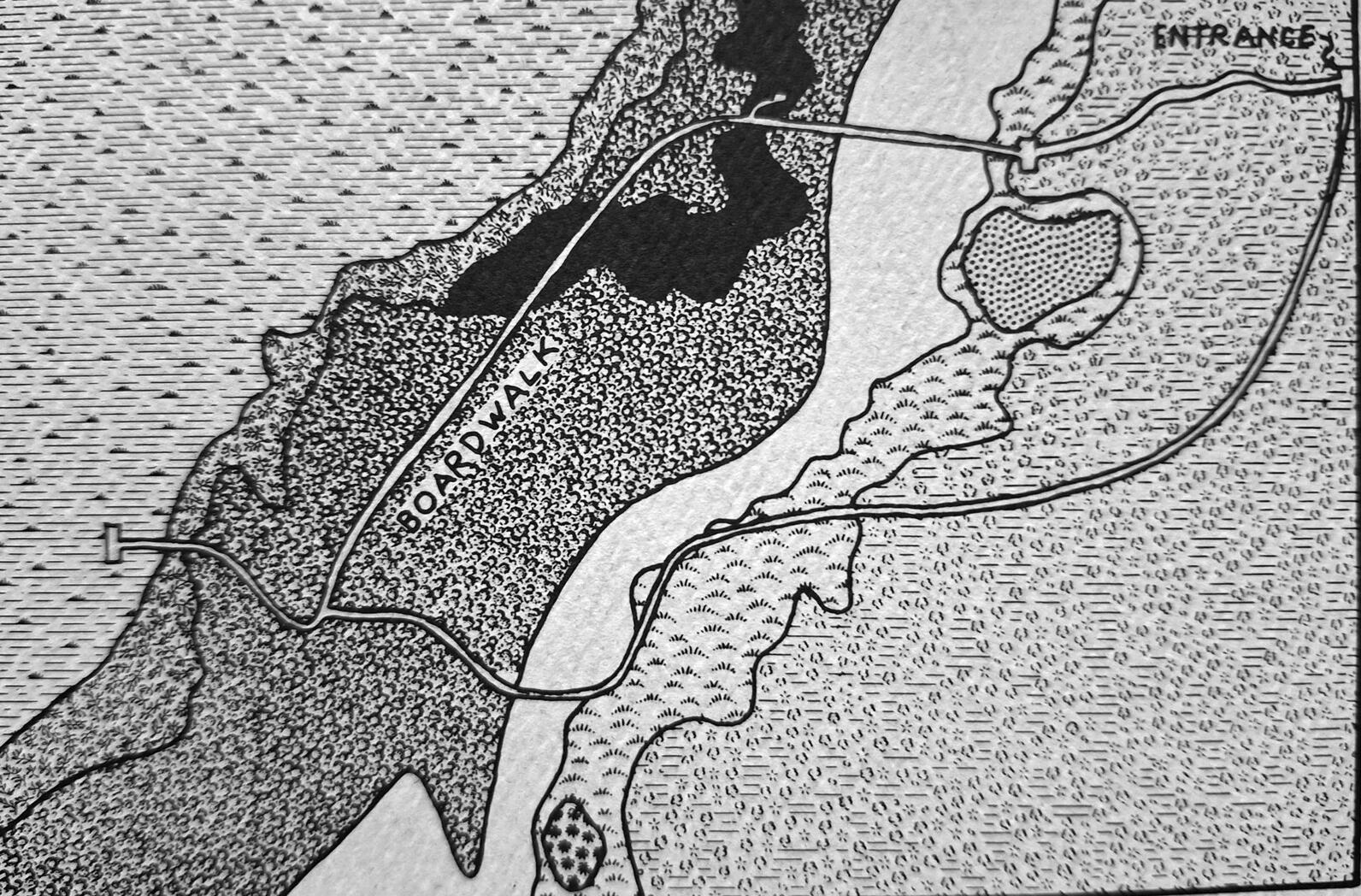
With cypress wood no longer readily available, the team used pine instead. The posts consisted of “lighterd" wood, which is pine naturally impregnated with rosin and almost rot-proof. The joists and decking were pressure-treated to minimize decay. Despite using the best materials available at the time, maintenance and upkeep required constant funding support.
The Second Boardwalk
The pine boardwalk served visitors for nearly 30 years. In the early 1990s, with visitation approaching 70,000 people per year and flood waters submerging the boardwalk on a few occasions, managers realized they needed to replace the old structure and raise it up by a few inches. Requirements were that it be smooth and wide enough for wheelchairs, rot-, water-, and fire-resistant, and that it last a long time. After an extensive search for the hardiest and most sustainable wood available, the Sanctuary director selected ipe wood grown in sustainably managed tropical forests in Brazil.

Ipe wood, also known as pau lope, is five times harder than pine and is fire and insect-resistant—an ideal material for a boardwalk through a Florida swamp. Surprisingly, the wood was so durable it was virtually nail-proof. Workers need battery-powered drills to pre-drill holes and then install the stainless-steel hardware. It is even dense enough to resist fire.
The new boardwalk was completed on December 26, 1995, with the final spurs completed the following spring. At 2.25 miles in total length, it was considered the fifth-longest boardwalk in the world, and wowed visitors with its gentle flow, meandering like a stream through the bald cypress, pond apple, and red maple trees. It navigates around large trees and, in a few places, enables trees to rise through its center.
While ipe was projected to withstand normal wear and tear for 100 years, managers learned that constant exposure to the swamp elements took its toll on the wood, and facilities staff and volunteers continually needed to make repairs. They also learned that ipe was no match for falling 500-year-old cypress trees.
Following a relatively uneventful twenty-two years, Hurricane Irma, a powerful Category 3 storm, hit Naples on September 10, 2017. With peak wind gusts of 142 mph recorded in Naples, the center of the storm path passed less than six miles from Corkscrew’s Blair Audubon Visitor Center. The storm dropped 12.6 inches of rainfall in the Sanctuary, bringing water levels to 4.17 feet, the fourth-highest on record.
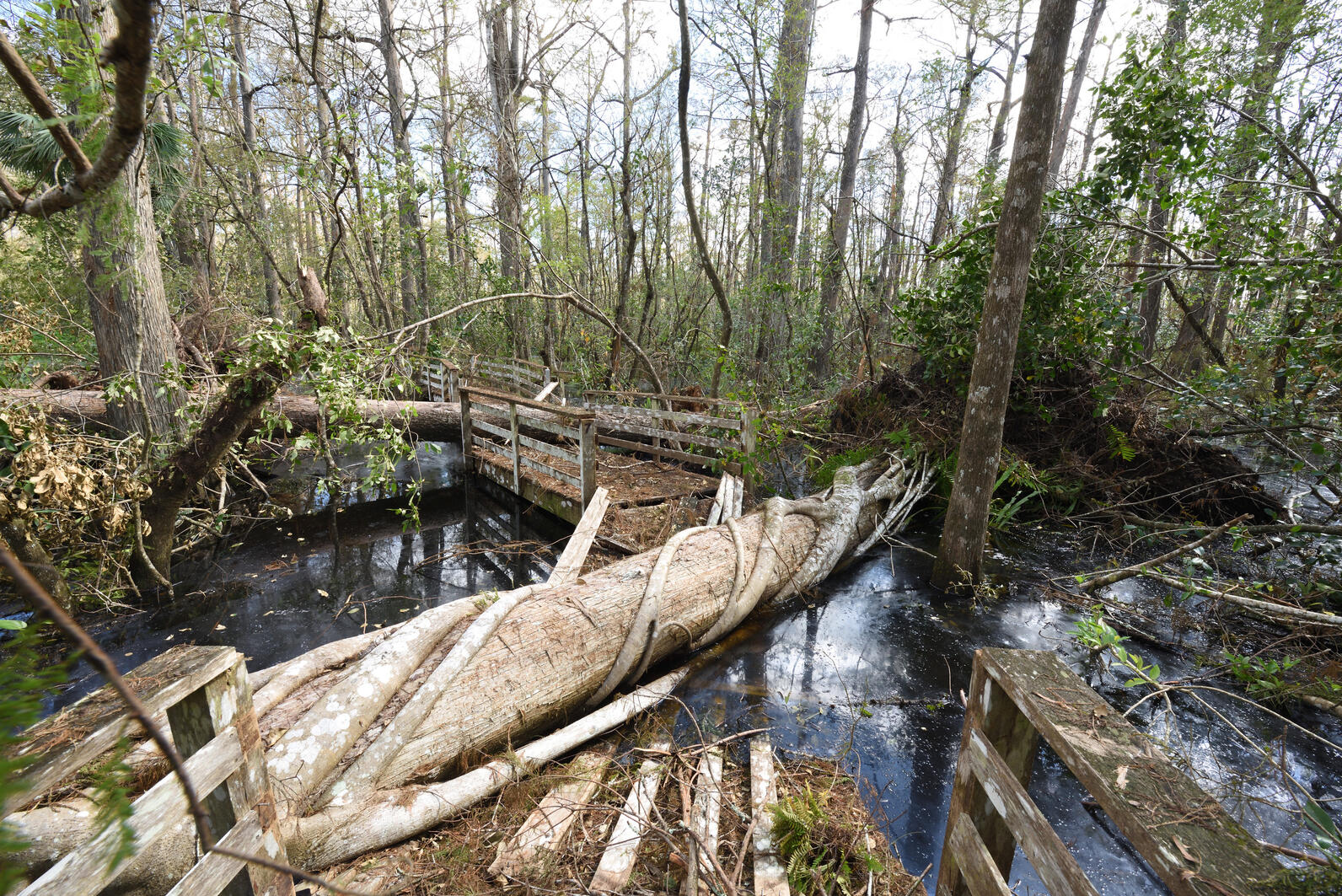
Irma caused heavy tree damage and felled several cypress trees that had stood for centuries, resulting in breaches to the boardwalk in 24 places and a 560-foot section of the boardwalk completely knocked out. More lumber was needed, but by this point, the ipe forest was no longer being sustainably harvested.
The Search for Replacement Lumber
Since the construction of the first boardwalk, conventional wisdom confirmed that a swamp sanctuary is no place for traditional lumber that is treated with chemical preservatives for waterproofing. Especially after Irma, suitable alternatives were few and far between. The team repaired some sections with black locust wood, which is sustainably harvested domestic hardwood, Class A fire rated, and relatively durable, but not as long-lasting as ipe.
Over the years, managers experimented with recycled plastic and fiberglass materials and even built some boardwalk sections to test those materials. However, most non-wood products were slippery when wet, unpleasant to touch when dry, and not fire resistant.
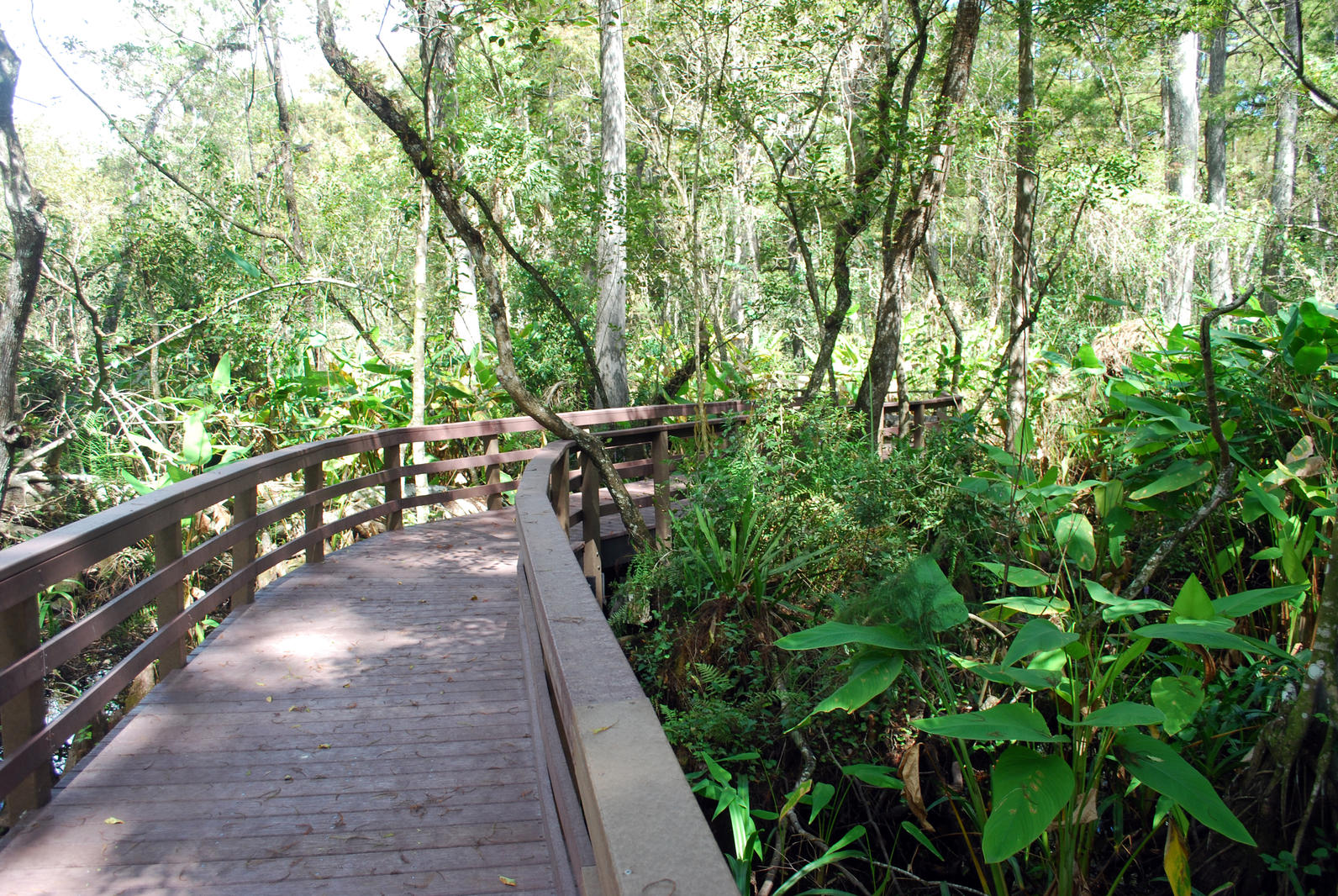
The section of the boardwalk broken by Irma closed for more than two years. in 2020. repairs and replacement sections were possible thanks to overwhelming support from the community and Florida Power & Light Company (FPL) through its charitable arm, the NextEra Energy Foundation. This new boardwalk section consists of FiberForce© lumber, made with post-consumer recycled products like milk jugs and cleaning product bottles, making it a resilient and environmentally sustainable choice.
Newer synthetic materials look much more like natural wood and are being considered for future repairs and eventual replacement, at least for the inner areas where the swamp elements are harsher on the boardwalk. Exterior sections that are adjacent to more fire-prone habitats are likely to remain wood, such as black locust.

Today, Corkscrew Swamp Sanctuary’s beloved boardwalk gives all who meander its 2.25 miles an immersive experience within the largest remaining, old-growth bald cypress forest in the world. From the deep bellow of an alligator to the powerful whoosh of Wood Stork wings, the exhilarating sightings of countless species continue to stop visitors in their tracks, thanks to the boardwalk.
Corkscrew Swamp Sanctuary's boardwalk requires constant upkeep and repair, totaling some 10,000+ hours and $105,000 funding for labor and materials on average per year. Admission fees, memberships, and donations support the full operation of the Sanctuary, including staff, land stewardship of 13,000+ acres, the Western Everglades Research Center, and educational programming for nearly 100,000 annual visitors and learners of all ages.
Please consider donating in support of our beloved boardwalk.



